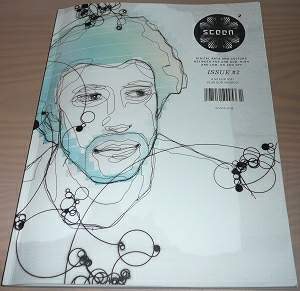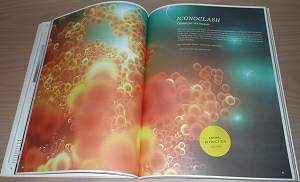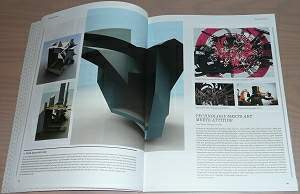
Sceen #2 review
Written by Bobic / back2roots.org & 4Sceners.de
Translation from German by Adok
Movies produced with the engine of Halo or UT2004. Real-time art from the demoscene, visual feast for the eyes brought into the disco by VJs and music from the digital underground? The stylish print magazine SCEEN informs about all these things and much more. We've taken a look at the recently released second issue.

"Good things take a while", is a German proverb. Alexander "Monroe" Scholz, main editor, layout artist and driving force behind the magazine SCEEN can tell you a thing or two about that. The second issue of his print mag, the content of which he describes as "Digital arts and culture betweenpop and sub, high and low, on and off", that is something that attracts the mainstream as well as the geek, the nerd the artist and the one who's working in the digital underground, has gone through an odyssee of almost two years. The first issue was released in August 2005 at the Evoke demo party in Cologne. Issue two was scheduled for mid 2006. Nobody could foresee that in the end, it would take until the end of 2007 for the magazine resembling almost a paperback to be released. But it's been worth the waiting.
Stylish & high quality
The love of details with which SCEEN issue #2 was made is noticeable at first glance. Already the first issue was a little artwork. But number two beats it in every aspect, regarding the production, the selection of topics as well as the DVD which is filled to bursting. First of all the 100-page-strong magazine is a pleasure for the eye. The cover artwork manages to convey the modern, artistic aspect. It shows the portrait of Navis, programmer of the demo group Andromeda SOftware Development, whose face is only outlined with strokes, while lines, circles and tender colours display a level of abstraction that could have directly come from a demo like Iconoclast or LifeForce. If you leaf through the pages you'll notice the clearly structured texts which are often broken up by large images and stylish portraits. Concerning the layout the second SCEEN hits the nerve of the time perfectly, as it connects lifestyle with the style of the digital underground.

The texts are all in English, and to understand them you need to have a slightly better knowledge of the English language than the usual school English. Alex and his crew prove that they have style, having pressed the texts in excellent wordings, sometimes entering poetical regions, which makes the reports exciting, interesting and at the same time somewhat atmospherical. The contents can be roughly divided into four large areas of topics: machinima, VJ-ing and micromusic. SCEEN #2 gives a perfect overview about the manifold possibilities and creative forms of digital art, lets one take a look beyond one's own nose and broadens one's horizon.
Visuals vs. Music
A game hater suddenly discovers the creative possibilities of editors of games such as UT2004 and Halo. What partly abstract films the freaks create with them, somewhat similar to the real-time shows of the demoscene. Or what absurd art is shown at various animation and film festivals, among it Robert Seidel's awarded computer animated short film _grau. One also learns about crazy people (in a positive sense) like Alex Dragulescu. The Romanian graphician has developed a program that analyzes the tiresome spam emails, evalutes keywords and characters and visualizes them as abstract 3D graphics. The result is impressive and only one of many types of modern art on the computer.
About a quarter of the contents are about the demoscene. Here you read about the history of the Greek demo group Andromeda Software Development, what's Minas/Calodox's motivation for creating 4k intros, and ten well known sceners have been asked about several demos, which resulted in interesting and partly extremely controversial opinions. This is a feature which should in any case be kept regularly.

A main focus of the current issue is dedicated to VJ-ing. Adding visual effects to music is an art growing steadily more popular. The SCEEN staff talked to Addictive TV, the kings of the VJ scene. There is background information on VJ tools, you get to see the lunatic images of the respective shows and many other artists speak out. However, music without a image trip is still important. While the first issue focused on netlabels, this time the focus is on micromusic - creating electronic sound and putting sounds from the C64 area beneath it. That's also being done by a superstar like Timaland, even if it's illegal. Disrupt/Jahtari.org, on the other hand, need not be afraid of suits in the order of a million. He combined chip sound with reggae and talks about it. The guys from 1bit wonder are also dedicated to micromusic, and there's an article about them.

Reading and watching
All of this and more can be read in SCEEN #2 - and also watched. The included DVD contains all the reviewed films, demos and cuts from the gigs of the featured artists, both as files and on the video track. Thus SCEEN issue #2 becomes a mandatory reading for everybody who is interested in digital culture and wants to learn more about the entire artistic spectrum. With a few articles you however notice the long development time of two years as something has happened in the described areas in the meantime, and yet this does't make the reading less interesting. The time to wait for the third issue of SCEEN is supposed to be far less.
SCEEN issue #2, 100 pages filled to bursting with interesting reports about all aspects of digital culture and art.
Price: EUR 9.95
Content: 100 pages, incl. DVD
Language: English
Homepage: www.sceen.org
Ordering information:
SCEEN issue #2 (CSW-Verlag)
SCEEN issue #2 (Amazon.de)
Bobic
This article was originally published on www.4sceners.de in the German language. Thanks to Bobic for allowing us to publish his review in Hugi#34.